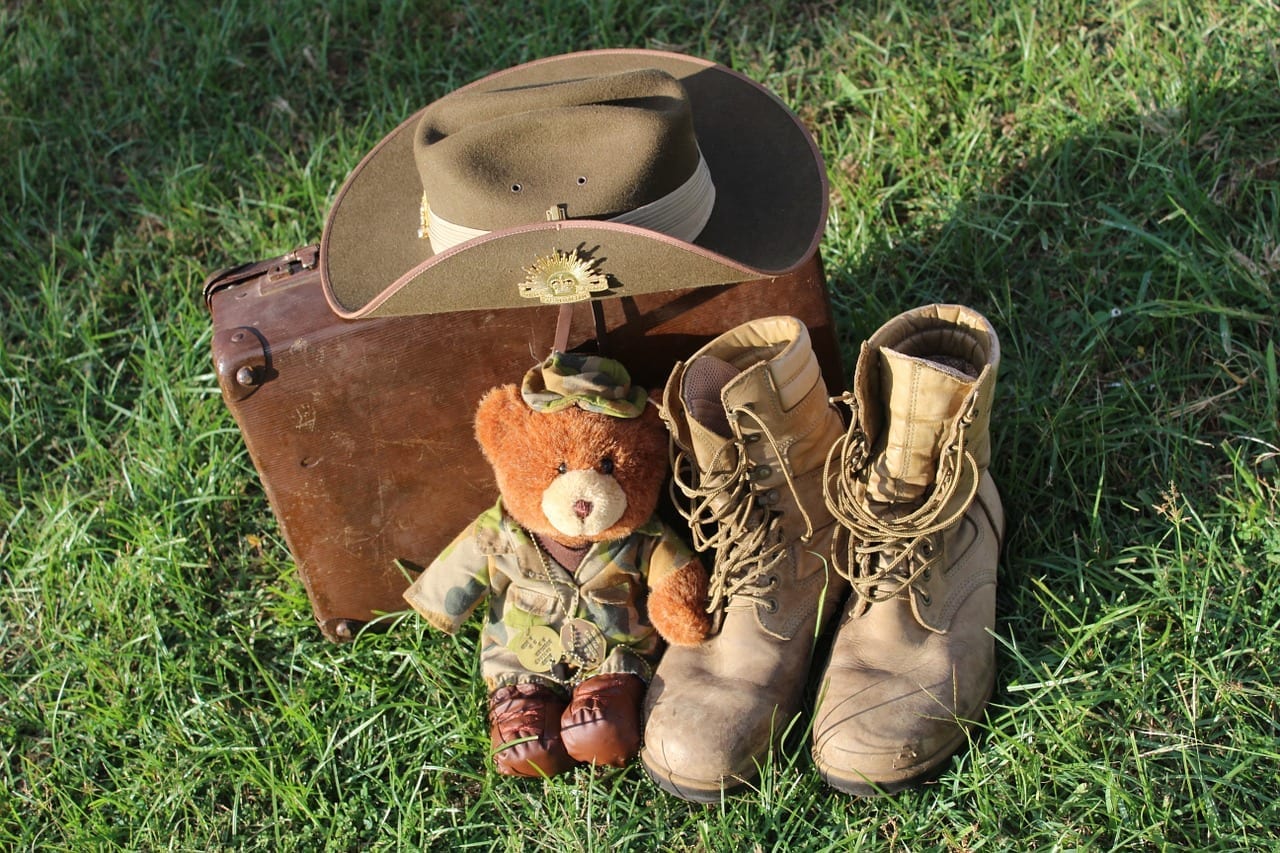Tags: War. History. Defensive Military. World War 1. World war 2. Army bases. Historical. Queensland. Forts.
WAR RELIC was HOLIDAY HOME on Bribie
We have recently been contacted by a lady from Brisbane with wonderful childhood memories of living in one of the Fort Skirmish Military buildings at Woorim. It is one of only 2 remaining building in the area of Rotary Park, which is soon to have informative signs erected and improvements carried out.
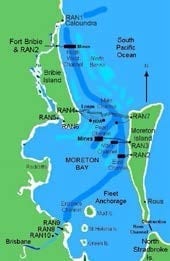

1. Diagram of Defence installation during WW2(left) and 4. Rooms as Holiday home for Olsen family 1958 to 1969(right)
The structure is known as RAN 4 and was the Control Room for submarine detection cable laid on the sea floor, across to Stradbroke Island to detect and destroy enemy ships. There were several defensive installations throughout Moreton Bay which are shown on the diagram.
After the war, the military equipment was removed but the structures remained. There were 5 rooms in the Control room building, for various equipment and wartime observation activities, plus a toilet for the Officers and another for the ratings. The layout and use of the rooms during the war years are shown in the diagram.
Further back from the sea was the accommodation camp for about 40 servicemen plus various other military structures. The only other building that has survived is one of the Generator rooms which is still visible in Rotary Park. Soon after the war, the submarine cables were recovered and most buildings were removed or lost in the shifting sand dunes. By 1953 the RAN 4 Control Room was almost out of sight under the sand. Between 1948 and 1953 the Control room structure was used as a “weekender” by Brisbane butchers Bertha and Ern Koppe under a special lease.
They installed double bunks and turned the Loop, Wireless and Observation rooms into bedrooms, and the Artificers Workshop became the kitchen. The lease was taken over by Ray and Joan Craft who continued to use it as a weekender until 1958. They installed a wood stove but were unable to leave anything at all in the building when they were not there as it had no windows and was not secure.
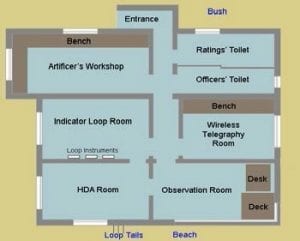
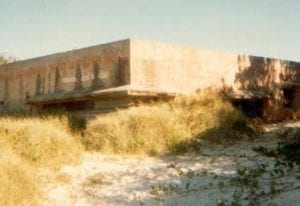
3. Military use of rooms during the War(left) and 2. In 1953 it was almost buried before the Olsen family moved in(right)
Bribie Island was still quite remote in those days with only a car ferry from the mainland to the island, and a population of about 400 people. The road across the island was rough and basic and there was only a sandy track from the Hotel north to the Control room. Other families also leased Gun Emplacement structures opposite Fourth Avenue, and Leanne and Viv Daddo had use of the tiny Generator room still standing in Rotary Park.
Everything required for the holiday visits had to be carried in and taken back home afterwards. On 12th March 1958 Frank and Oral Olsen took over the lease of RAN4 Control room and continued to use it as a holiday home for the next eleven years until end January 1969. By 1970 the building was so broken down and unsafe that it could no longer be used. Helga Newmann (nee Olsen) recently wrote the following letter to the Historical Society with her memories of those days and provided a diagram of how they used the rooms as a home.
My memories of holidaying at “The Fort” Bribie Island
Between March 1958 and January 1969, my family (parents and five children) holidayed at various times (school holidays) at Bribie Island staying in “The Fort” leased by my Uncle Francis Lloyd Olsen (Frank Olsen). We would catch the barge over from Toorbul Point to Bribie Island then drive across the island towards the ocean beach.
The road into the fort was only a poorly maintained sandy track through the bush. First thing when we arrived Dad started the windmill so we could have water and got the kerosene refrigerator going.
There was no electricity so we used primus lanterns for lights, a kerosene refrigerator and a wood stove. I don’t remember stockpiles of wood for the stove so maybe we had some other means of cooking but I don’t recall. Maybe a primus stove. The windows would have had bars but I don’t recall whether there was glass in them.
The sand dunes actually came right up under the windows (within a foot of the windows) on the beach side. People used to wander along the beach and stop to look in the window. Many a time you’d surprise somebody looking in at you.
We used to swim and fish in the surf right in front of the fort. We also did lots of walking going to some of the inland lagoons. It was wonderful at night to lie in bed and listen to the only sound – the ocean breaking on the shore – and shadowy figures walking past the doorway when Mum and Dad passed with a lantern. Helga Newmann (nee Olsen) Brisbane Qld, April 2017
SAVING OUR WAR HISTORY


5. Control room before Rotary Restoration in 1996(left) and 6. Restoration work by Rotary volunteers in 1996/7(right)
After 1970 the Control Room building continued to deteriorate and became extensively vandalised over the next 25 years until in 1996 the newly formed Rotary Club of Bribie Island initiated a Project to refurbish the building. Volunteers worked for many months inputting thousands of volunteer hours to uncover the building, clean and paint the interior rooms and external structure.
When completed it was almost as good as new and was positioned just above the high water mark. Despite the efforts of Rotary, there was no interest by State or Council to provide adequate protection or signage. In subsequent years king tides and storm surges eroded the protective sand dune in front of the Control Room, and vandals continued to break into the building and deface the restoration work.
A major storm surge in 2011 removed large quantities of sand and seriously undermined the structure until it was almost lost. Council were then required to construct a large sandbag protective wall around the building, which now sticks out over the beach and is washed by the daily tide. Bribie Island Rotary Club have urged Council for many years to recognise the significance of these structures and to improve the facilities in Rotary Park and erect their informative signage.
This work is scheduled to take place soon and it must be hoped that this will raise public awareness and respect for these important historical relics. For more than a decade the Historical Society has urged State Government to recognise the almost complete loss of World War 2 structures at Fort Bribie on the north of the island. There are now very few remaining structures remaining intact.


8. Storm erosion in 2011 almost claims Control room(left) and 7. After Rotary restoration vandals struck again in 2000(right)
I have recently taken 40 people as one of Councils Public programs, to see the inside of the Control Room and appreciate the role of Bribie Island in WW2. The interior is rapidly deteriorating due to extensive concrete cancer, and its ultimate collapse seems inevitable. Such a pity.

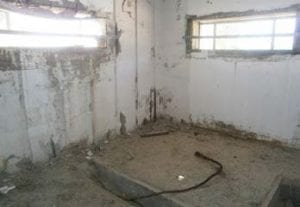
9. Protective Sandbags after storms of 2011(left) and 10. What it looks like inside today(right)
It was lovely to hear from Helga (nee Olsen) with her memories of many exciting holidays with her family, living in an empty concrete bunker on the water’s edge ….a million dollar location. We should all be reflecting on just how close Australia came to being invaded during the war, and the strategic role of the buildings and those who served on Bribie Island during those challenging years.
